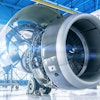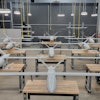Just-in-time (JIT) deliveries, little to no inventory, outsourcing, sole sourcing — all of these “lean” concepts have been at the heart of operations management for years now. But more and more companies are starting to ask themselves a simple question. Just how lean do we really want to be? In answering that question, many are starting to rethink the way they manage their processes and supply chains.
The first warning shot across the bow of lean, and a sign that supply chains might be overstretched, came in the form of the Severe Acute Respiratory Syndrome (SARS) outbreak in China in 2002-2003. While the epidemic caused some delivery delays and lost sales, for the most part manufacturing in the region went undisturbed, so companies continued looking for ways to keep their supply chain lean.
 Close to 10 years later, a series of unfortunate events began with an earthquake and tsunami hitting Japan in March of 2011. In contrast to the relatively subtle supply chain shifts which resulted from the SARS outbreak, this dual disaster caused many local automotive suppliers to completely shut down, resulting in worldwide shortages of vital components.
Close to 10 years later, a series of unfortunate events began with an earthquake and tsunami hitting Japan in March of 2011. In contrast to the relatively subtle supply chain shifts which resulted from the SARS outbreak, this dual disaster caused many local automotive suppliers to completely shut down, resulting in worldwide shortages of vital components.
In November of that same year, major flooding struck Thailand, throwing the supply chains of several high-tech companies into utter disarray. Seagate, a major provider of hard drives for PCs, said at the time that it would probably take two years to get its supply chain back to normal. Shortly thereafter, in 2012, a major explosion at a specialized chemical plant in Germany (Evonik Industries) resulted in global automotive supply chain disruptions and compromised manufacturing across the globe.
A key lean trend is consolidating suppliers and doing away with redundancies. Although this certainly creates cost efficiencies, the main suppliers who are left quite often end up providing needed parts to many companies in the same industry. And if these companies are all depending on the same supplier, or only a few suppliers, unforeseen production problems or sudden shifts in demand can easily send ripples throughout multiple systems.
In certain industries, say aerospace, these rare resource problems usually aren’t found within the larger tier one suppliers, but rather further out in the supply network with the tier two and tier three providers. At those tier levels, many suppliers are usually smaller and more focused companies that already have a difficult time adapting their operations to meet demand fluctuations. As proof of the challenges that many suppliers are facing, the Original Equipment Suppliers Association says that since 2008 alone, 57 U.S. manufacturers have either gone out of business or were taken over by another company.
What all this means is that thanks to the combined trends of consolidating suppliers and reducing in-house production capabilities (i.e. outsourcing), many companies have been caught with no “plan B” in the event of a disruption. As a result, some managers are taking another look at how they run their operations and re-evaluating their formerly ravenous appetite for lean.
One example of a company re-evaluating its options is Airbus’ development of their A350 wide-body aircraft. To pro-actively address lean supply issues, the company fundamentally changed its operations and supplier management approaches. Unlike Boeing’s choices for its 787 Dreamliner, Airbus made a conscious decision to try and keep more design and fabrication work “in-house” (initial reports stated that that Boeing wanted to outsource as much as 70 percent of the work on the 787 versus 50 percent for Airbus’ A350).
Airbus integrated key suppliers, giving them access to its internal network and systems, and the company engaged in better oversight, monitoring the activities of about 450 suppliers and subcontractors around the world. When a problem arose, the company didn’t hesitate to send out scores of engineers and experts to give its supply chain partners help and guidance — the exact type of thing you would normally avoid when you outsource. It may have added to some short-term costs, and may not exactly align with lean priorities, but in this case, the improved quality of the long-term supplier relationships more than made up the difference.
While some companies are in no way abandoning lean concepts, many are starting to take a second look at practices that were once considered lean “heresy” so that they can improve the resiliency of their supply chains. Having some buffer inventories of vital components or material on hand, or using multiple suppliers, might be good idea for a company that wants to protect itself from disruptions. Another option could be to bring more fabrication work in-house, or at least have the capacity to do so, in the event of an emergency.
Regardless of the options, managers need to continually weigh the pros of a lean and efficient supply chain against the costs of building in redundancies and flexibility. Every decision requires trade-offs. Depending on your business, some higher costs might be worthwhile if the trade-off is the ability to provide higher levels of customer service and avoid lost sales, no matter which way the storm blows.
Dr. Tom McNamara is an Assistant Professor at the ESC Rennes School of Business, France, and a former Visiting Lecturer at the French National Military Academy at Saint-Cyr, Coëtquidan, France. Dr. Erika Marsillac is an Assistant Professor in Maritime and Supply Chain Management at Old Dominion University, Norfolk, VA, USA and a former lecturer at the ESC Rennes School of Business, France.
Sources
“Airbus A350 Faces Supply Chain Challenge” by Heather Rushworth, Digital Supply Chain, January 22nd, 2012. Accessed at: http://www.supplychaindigital.com/procurement/airbus-a350-faces-supply-chain-challenge
“Airbus and Boeing push supply mergers” By Andrew Parker and James Shotter, July 8, 2012, Financial Times. Accessed at: http://www.ft.com/cms/s/0/2b66574a-c73b-11e1-849e-00144feabdc0.html#ixzz25oI9XGrp
“Airbus Delays A350 Model” By Jan Hromadko and Daniel Michaels, The Wall Street Journal, July 27th, 2012. Accessed at: http://online.wsj.com/news/articles/SB10000872396390443343704577552271767158452
“Airbus Developing ‘Stretch Marks’ as Supplier Strain Hurts Sales” By Robert Wall and Andrea Rothman, September 4, 2012, Bloomberg News. Accessed at: http://www.bloomberg.com/news/2012-09-04/airbus-developing-stretch-marks-as-supplier-strain-hurts-sales.html
“Airbus 'to outsource A350 work'” BBC, November 28, 2006. Accessed at: http://news.bbc.co.uk/2/hi/business/6192960.stm
“Crises make automakers rethink lean parts supplies” By Dee –Ann Durbin and Tom Krishner, April 20, 2012, Associated Press. Accessed at: http://cnsnews.com/news/article/crises-make-automakers-rethink-lean-parts-supplies
“Dreamliner problems may also delay Airbus' new A350” The Syndney Morning Herald, January 23rd, 2013. Accessed at: http://www.smh.com.au/travel/travel-news/dreamliner-problems-may-also-delay-airbus-new-a350-20130123-2d66f.html
“Hit by Delays, Airbus Tries New Way of Building Planes” by Daniel Michaels, The Wall Street Journal, July 11th, 2012. Accessed at: http://online.wsj.com/news/articles/SB10001424052702303879604577407861198472788
“Suppliers face battle to meet plane order backlog” By Victoria Bryan and Karen Jacobs, July 11, 2012, Reuters. Accessed at: http://in.reuters.com/article/2012/07/12/airshow-suppliers-idINL6E8IC2EP20120712
“Supply chain disruption: sunken ambitions” By Ben Bland and Robin Kwong, November 3, 2011, Financial Times. Accessed at: http://www.ft.com/cms/s/0/6b20d192-0613-11e1-ad0e-00144feabdc0.html#ixzz25Lni2GRc
“The global supply chain: So very fragile” By Bill Powell, December 12, 2011, Fortune. Accessed at: http://tech.fortune.cnn.com/2011/12/12/supply-chain-distasters-disruptions/
“The Airbus A350” The Economist, June 14th, 2013. Accessed at: http://www.economist.com/blogs/schumpeter/2013/06/airbus-a350
“THE SARS EPIDEMIC: THE ECONOMIC IMPACT; Economies Sickened by a Virus, and Fear” by KEITH BRADSHER, The New York Times, April 21, 2003. Accessed at: http://www.nytimes.com/2003/04/21/business/the-sars-epidemic-the-economic-impact-economies-sickened-by-a-virus-and-fear.html?pagewanted=all&src=pm
“What Went Wrong At Boeing?” by Steve Denning, Forbes, January 21, 2013. Accessed at: http://www.forbes.com/sites/stevedenning/2013/01/21/what-went-wrong-at-boeing/






















